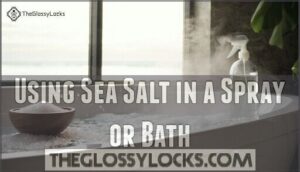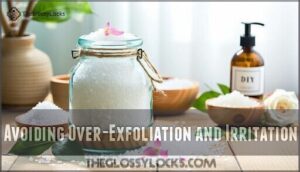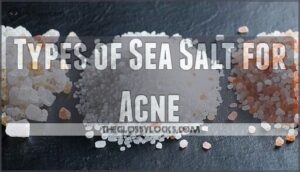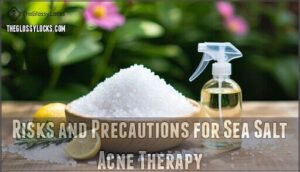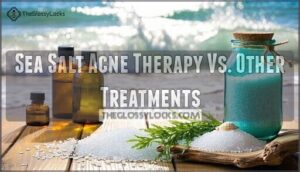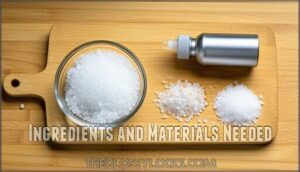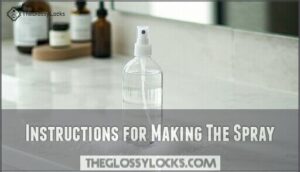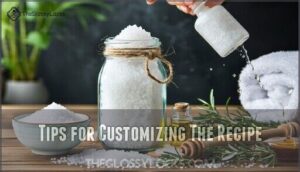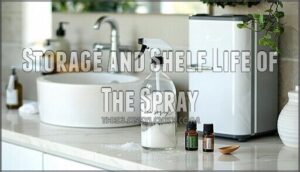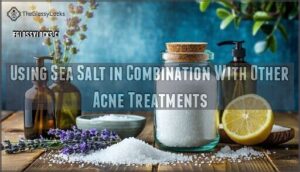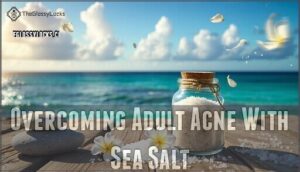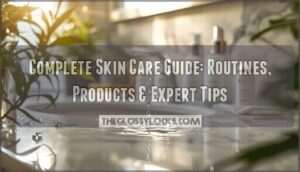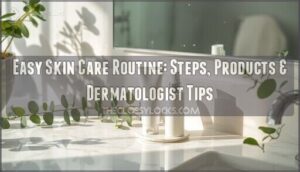This site is supported by our readers. We may earn a commission, at no cost to you, if you purchase through links.
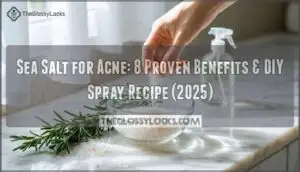
The minerals in sea salt, particularly magnesium and sulfur, help reduce inflammation and redness while gently exfoliating dead skin cells that clog pores.
It’s like giving your skin a mini spa day at home.
Sea salt also draws out excess oil and creates an environment less friendly to acne-causing bacteria.
However, don’t expect miracles – it works best for mild acne and as a complement to proven treatments like salicylic acid.
The key is using it correctly to avoid irritation.
There’s a specific technique that makes all the difference.
Table Of Contents
- Key Takeaways
- Benefits of Sea Salt for Acne
- How to Use Sea Salt for Acne
- Types of Sea Salt for Acne
- Risks and Precautions for Sea Salt Acne Therapy
- Sea Salt Acne Therapy Vs. Other Treatments
- Creating a Homemade Sea Salt Spray
- Using Sea Salt in Combination With Other Acne Treatments
- Overcoming Adult Acne With Sea Salt
- Frequently Asked Questions (FAQs)
- Is it okay to put sea salt on your face?
- What is sea salt acne therapy?
- Is Himalayan salt good for pimples?
- Does sea salt cause acne?
- Is Dead Sea salt good for acne?
- Does sea salt help with acne?
- Is it good to put sea salt on your face?
- Which salt is good for pimples?
- Is salt good or bad for acne?
- Can sea salt worsen skin dryness in winter?
- Conclusion
Key Takeaways
- Sea salt works best for mild acne as a supplement – It can reduce inflammation and gently exfoliate, but you’ll need proven treatments like salicylic acid or benzoyl peroxide for moderate to severe breakouts.
- Dead Sea salt offers the most benefits – You’ll get superior results with Dead Sea salt’s 21+ minerals compared to regular table salt, which lacks therapeutic properties and may irritate your skin.
- Use it correctly to avoid irritation – You should dilute sea salt properly (1 teaspoon per cup of water), limit use to 1-2 times weekly, and always moisturize afterward to prevent over-drying and barrier damage.
- It’s not suitable for sensitive skin types – If you have eczema, rosacea, or very sensitive skin, sea salt can worsen inflammation and cause allergic reactions, so you’ll need gentler alternatives.
Benefits of Sea Salt for Acne
You’ve probably heard that sea salt can help clear up acne, but understanding exactly how it works will help you use it safely and effectively.
The minerals in sea salt, particularly magnesium, offer anti-inflammatory properties that may reduce the redness and swelling associated with breakouts.
Sea salt’s magnesium works as nature’s gentle anti-inflammatory, calming angry breakouts without harsh chemicals.
Reduces Inflammation With Magnesium
When inflammation strikes your skin, magnesium in sea salt becomes your ally for acne relief. This essential mineral delivers powerful inflammation reduction by calming irritated tissues and supporting cellular repair.
Magnesium benefits extend beyond surface-level soothing—it helps regulate hormonal fluctuations that trigger breakouts while promoting healthier skin barrier function. Understanding the role of skin inflammation causes can further enhance the effectiveness of sea salt in acne treatment.
- Freedom from persistent redness and angry bumps
- Relief from the burning sensation of inflamed acne
- Confidence knowing you’re using gentle mineral therapy
- Liberation from harsh chemical treatments that overdry skin
- Belonging to those who’ve discovered sea salt’s antiinflammatory power
Acts as a Natural Exfoliator
Sea salt’s natural exfoliator properties work like nature’s gentle scrub, buffing away dead skin cells that clog pores.
This gentle peeling action helps your skin breathe again.
| Exfoliation Benefits | How It Works |
|---|---|
| Skin Smoothing | Removes rough, flaky patches |
| Pore Clearing | Unclogs blocked follicles naturally |
| Natural Scrub Action** | Minerals restore mineral balance |
However, moderation matters—over-exfoliation can backfire and irritate your complexion.
May Help Reduce Oil Buildup
Beyond exfoliation, sea salt for acne tackles another culprit: excess sebum.
Your skin’s oil control gets a helping hand when salt absorbs surplus oils that clog pores.
This sebum regulation creates better skin balance, reducing that unwanted shine while supporting pore minimization.
When combined with proven natural remedies, salt helps prevent oil buildup that leads to breakouts, making it a valuable tool for acne prevention.
Can Soothe Redness and Irritation
Red, angry skin meets its match with sea salt’s mineral-rich formula.
The magnesium naturally calms inflammation while zinc targets irritation at its source.
You’ll notice how sea salt for acne provides redness relief without harsh chemicals.
This skin calming effect makes it perfect for sensitive skin types who need gentle inflammation control that won’t exfoliate acne skin too aggressively.
How to Use Sea Salt for Acne
Using sea salt for acne requires careful technique to maximize benefits while protecting your skin barrier.
You’ll want to choose the right type of salt, apply it properly through sprays or baths, and avoid the common mistake of over-exfoliation that can worsen breakouts, which is crucial for maintaining a healthy skin barrier.
Choosing The Right Type of Sea Salt
Not all salt is created equal in the context of sea salt acne treatment.
Dead Sea salt contains twenty-one minerals, making it superior to standard varieties for reducing inflammation.
Fine granules work better than coarse salt granules for gentle facial exfoliation.
Choose unrefined, additive-free options from clean harvesting methods.
Avoid processed table salt—it lacks beneficial minerals and can irritate skin.
When selecting a product, consider the benefits of Dead Sea products for ideal results, using Dead Sea salt for its unique properties.
Using Sea Salt in a Spray or Bath
Once you’ve selected your sea salt, application methods matter for ideal skin detox results.
Here are proven techniques:
- Sea salt spray: Mix 1 teaspoon sea salt with 8 ounces warm water in a spray bottle for targeted acne treatment
- Bath soak: Add 1/4 cup sea salt to warm bathwater for mineral absorption and full-body exfoliation methods
- Quick rinse: Splash diluted sea salt solution on affected areas, then rinse with fresh water
- Gentle pat: Apply with cotton pad to avoid over-scrubbing and maximize salt spray benefits
Understanding the natural hair texture is also vital for overall skin and hair care.
Avoiding Over-Exfoliation and Irritation
Over-exfoliation creates more problems than it solves—your skin barrier needs protection, not punishment. Gentle exfoliation twice weekly prevents skin irritation while maintaining your daily routine.
| Factor | Safe Practice | Warning Signs |
|---|---|---|
| Frequency | 1-2 times weekly | Daily scrubbing urges |
| Pressure | Light, circular motions | Aggressive rubbing |
| Duration | 30-60 seconds max | Extended scrubbing sessions |
| Aftercare | Moisturize immediately | Skipping hydration |
Sensitive skin requires extra caution with sea salt acne treatment—gentle scrubbing prevents acne inflammation reduction while avoiding irritation control issues.
Pairing Sea Salt With Gentle Cleansers
Beyond avoiding over-exfoliation, you’ll want to pair your sea salt acne treatment with gentle cleansers that won’t strip your skin’s mineral balance.
The right cleanser types create harmony with salt’s natural exfoliating properties while maintaining proper skin pH levels.
Choose cleansers that complement your sea salt face wash routine:
- Low-pH formulas (around 5.5) that support your skin’s natural barrier function
- Cream-based cleansers with ceramides that lock in moisture after salt concentration exposure
- Oil-based options like sweet almond that dissolve impurities without harsh surfactants.
This combination transforms your natural acne remedies into a powerhouse duo.
The gentle exfoliants work synergistically, letting sea salt benefits skin without compromising your protective barrier—think of it as acne skin care teamwork.
Types of Sea Salt for Acne
Not all sea salts work the same way for acne treatment, and choosing the right type can make a significant difference in your results.
Dead Sea salt contains the highest concentration of beneficial minerals, while regular table salt may actually irritate your skin more than it helps, which is why selecting the correct type is crucial for effective acne treatment.
Dead Sea Salt Benefits
Dead Sea salt stands out from regular sea salt with its exceptional Mineral Content – over 21 therapeutic minerals that support Skin Regeneration.
These Natural Antiseptics provide superior Inflammation Reduction while maintaining ideal pH Balance for acne-prone skin.
| Mineral | Concentration | Skin Benefit |
|---|---|---|
| Magnesium | 31-35% | Reduces inflammation, calms irritated skin |
| Calcium | 14-18% | Supports cell regeneration, strengthens barrier |
| Potassium | 20-28% | Retains moisture, prevents dryness |
| Bromide | 4-6% | Natural antiseptic properties |
| Sulfur | 0.05-0.2% | Antimicrobial action against acne bacteria |
Himalayan Salt for Acne
Himalayan salt’s mineral-rich profile makes it perfect for acne prone skin.
You’ll get gentle exfoliation plus natural treatment benefits from its 84 trace minerals.
Here’s what makes it special for your skin:
- Mineral Effects: Magnesium and zinc work together to calm inflammation
- Natural Remedies: Creates balanced pH levels that discourage acne-causing bacteria
- Skin Types: Works well on oily skin without over-drying like harsher treatments
Think of it as salt water for acne without the beach trip—these Salt Benefits help address Acne Causes naturally.
Other Types of Sea Salt for Skin Care
Various sea salt types offer distinct skincare benefits beyond basic sodium chloride.
Each variety contains unique mineral profiles that can enhance your acne-fighting routine.
Here are five specialty sea salts worth exploring:
- Fleur Salt: Premium French crystals with delicate texture for gentle sea salt facial treatments
- Black Salt: Volcanic minerals provide deep detoxification in homemade sea salt scrub acne formulas
- Hawaiian Salt: Red clay content adds iron and creates effective ocean mineral cleanser properties
- Persian Salt: Ancient deposits offer high purity for sensitive skin applications
- Smoked Salt: Adds aromatherapy benefits while maintaining exfoliating properties for acne care
Understanding the importance of salt purity levels is essential for maximizing the benefits of these sea salts.
Table Salt Vs. Sea Salt for Acne
When comparing table salt and sea salt for acne treatment, you’ll find key differences that matter for your skin.
| Aspect | Table Salt | Sea Salt |
|---|---|---|
| Mineral Content | Minimal minerals | Rich in magnesium, calcium, potassium |
| Processing | Heavily refined | Minimally processed |
| Texture | Fine, uniform granules | Coarser, irregular crystals |
| Sodium Content | Higher (2,300mg/tsp) | Lower (2,000mg/tsp) |
| Skin pH Impact** | More alkaline, harsher | Gentler on skin pH balance |
Sea salt offers superior mineral benefits for skincare.
Its magnesium content reduces inflammation, while gentler exfoliation methods prevent over-scrubbing.
Table salt‘s fine texture can scratch delicate facial skin, making sea salt scrub acne treatments safer and more effective for addressing acne causes.
Risks and Precautions for Sea Salt Acne Therapy
While sea salt can help with acne, it’s not risk-free and might cause more harm than good for some people.
Understanding these potential downsides helps you decide if this natural remedy fits your skin type and current skincare routine, which is crucial for making an informed decision about using sea salt, considering it as a potential skincare solution.
Potential Irritation and Dryness
Before diving into sea salt’s darker side, know that skin irritation and dryness risks are real concerns.
Sea salt can strip your skin barrier, leaving you with inflammation and dry skin that’s worse than your original breakouts.
Over exfoliation from coarse salt granules may cause skin damage, especially if you’re prone to sensitive skin.
This irritation can actually trigger more acne.
Not Suitable for Sensitive Skin
Beyond irritation and dryness, sensitive skin faces heightened risks with sea salt treatments.
Your delicate skin barrier can’t handle salt’s abrasive nature, potentially triggering:
- Severe skin inflammation that spreads beyond treated areas
- Allergic reactions causing painful welts or burning sensations
- Compromised skin barrier leading to chronic sensitivity issues
- Persistent dryness risks requiring weeks of recovery time
Sea salt for acne isn’t worth gambling with your skin’s health when gentler alternatives exist.
Interaction With Other Skin Conditions
If you have eczema triggers, psoriasis, or rosacea, sea salt can backfire.
Studies show 22% of people with dermatitis experience worsened symptoms from salt exposure. The coarse granules may irritate sensitive skin and disrupt healing in active lesions.
Skin sensitivity varies greatly—what soothes one person might inflame another. Always patch-test before diving in.
Sea Salt Acne Therapy Vs. Other Treatments
While sea salt offers natural anti-inflammatory benefits, it can’t compete with proven acne treatments like salicylic acid, benzoyl peroxide, and retinoids.
You’ll likely need these dermatologist-recommended options for moderate to severe acne, as sea salt works best as a gentle supplementary treatment rather than your main defense, utilizing dermatologist-recommended options for optimal results.
Salicylic Acid and Benzoyl Peroxide
Looking at acne treatments, salicylic acid and benzoyl peroxide outperform sea salt in clinical studies.
These proven ingredients target bacterial control and pore unclogging more effectively than natural remedies.
| Treatment | Mechanism | Success Rate |
|---|---|---|
| Salicylic Acid | Skin exfoliation, inflammation reduction | 27-40% improvement |
| Benzoyl Peroxide | Bacterial control, pore unclogging | 35-52% reduction |
| Sea Salt | Natural exfoliation | Limited data |
| Combination Therapy | Multiple pathways | Superior results |
| Cystic Acne Treatment | Targeted approach | Most effective |
Retinol and Retinoids for Acne
When facing stubborn breakouts, retinoids offer proven Acne Treatment results.
These vitamin A derivatives accelerate Skin Renewal, unclogging pores and reducing inflammation.
Dermatologist Advice consistently favors retinoids for Cystic Acne Treatment over natural remedies.
| Treatment | Effectiveness | Side Effects | Cost |
|---|---|---|---|
| Retinoids | High | Moderate | $$$ |
| Sea Salt | Low | Mild | $ |
| Salicylic Acid | Medium | Low | $$ |
| Benzoyl Peroxide | High | Moderate | $$ |
Retinol Benefits include Acne Prevention and anti-aging effects, making Skin Care routines more thorough than single-ingredient approaches.
Chemical Peels and LED Treatments
While retinoids work well, chemical peels and LED treatments pack serious punch for stubborn acne.
These professional options deliver deeper skin resurfacing than your typical sea salt solution.
| Treatment | Mechanism | Timeframe |
|---|---|---|
| Chemical Peels | Chemical exfoliation removes dead cells | 2-4 weeks |
| LED Therapy | Light reduces bacteria and inflammation | 4-8 weeks |
| Acne Laser | Targets oil glands and bacteria | 6-12 weeks |
Chemical exfoliation through glycolic or salicylic peels promotes faster cell turnover than manual scrubbing.
LED treatments use specific wavelengths to kill acne bacteria without harsh chemicals.
Both complement facial rejuvenation goals while targeting breakouts more aggressively than topical solutions alone.
Why Sea Salt May Not Be Enough
While sea salt shows promise as a natural remedy, it won’t cut it for moderate to severe acne.
You’ll need proven acne treatment options like salicylic acid or retinoids to address deeper skin issues.
Salt limitations become clear when dealing with stubborn breakouts that require stronger intervention.
Your skin sensitivity also matters – some people can’t handle sea salt’s drying effects.
| Treatment | Acne Severity | Skin Sensitivity |
|---|---|---|
| Sea Salt | Mild | Medium-High |
| Salicylic Acid | Moderate-Severe | Low-Medium |
| Retinoids | Severe | High |
| Chemical Peels | Moderate-Severe | High |
| LED Therapy | Mild-Moderate | Low |
Treatment gaps exist when relying solely on alternative therapies without addressing acne causes like hormones or bacteria.
A thorough skin care routine works best.
Creating a Homemade Sea Salt Spray
You can easily make your own sea salt spray at home using just a few simple ingredients from your kitchen.
This DIY approach lets you control the concentration and customize the formula to match your skin’s specific needs.
Ingredients and Materials Needed
Success starts with the right foundation for your DIY sea salt spray. You’ll need high-quality Sea Salt like dead sea salt soap or Himalayan varieties, distilled water to prevent bacterial growth, and optional natural skin cleanser enhancers.
Using a genuine sea salt product from a sea salt store can enhance the effectiveness of your spray.
- Sea Salt: Choose dead sea salt soap or Himalayan salt over regular table salt
- Distilled water: Prevents contamination and extends shelf life substantially
- Essential Oils: Add tea tree or lavender for antimicrobial benefits
- Carrier Oils: Include jojoba oil to prevent over-drying sensitive skin
Instructions for Making The Spray
Begin by dissolving 1 teaspoon of sea salt into 1 cup of warm, filtered water in your spray bottle.
Shake vigorously until the salt completely disappears – no grainy bits should remain.
The proper salt ratio guarantees your homemade sea salt spray won’t irritate skin or clog the spray nozzle.
Let the mixture cool to room temperature before first use, ensuring the homemade sea salt spray is used safely.
Tips for Customizing The Recipe
Customizing your homemade sea salt spray lets you tailor acne treatment to your unique skin needs.
Adjust salt ratios based on skin types—sensitive skin requires weaker concentrations, while oily skin tolerates stronger blends.
Try ingredient swaps like adding honey for moisture or tea tree oil for extra antimicrobial power.
Measurement tips: start with one teaspoon per cup, then adjust.
These custom blends make natural remedies work better for your specific concerns.
Storage and Shelf Life of The Spray
Store your sea salt spray in a clean, sanitized glass bottle with proper labeling requirements including the creation date.
This sodium chloride solution maintains peak effectiveness for 1-2 weeks when refrigerated.
Beyond this spray expiration window, bacterial growth becomes a concern.
Always practice proper bottle sanitizing between batches to prevent contamination and extend your homemade spray’s shelf life safely.
Using Sea Salt in Combination With Other Acne Treatments
While sea salt alone won’t clear stubborn breakouts, it can boost your existing acne routine when used strategically.
You’ll get better results by combining sea salt treatments with proven medications and healthy habits rather than relying on salt water as your only defense.
Pairing Sea Salt With Topical Creams
Adding sea salt to your topical acne treatments can boost skin exfoliation and reduce inflammation.
However, salt cream benefits come with risks—combining sea salt with retinoids or benzoyl peroxide may trigger irritation or dryness.
Start with patch testing these cream combinations before full application. Watch for skin reactions like redness or peeling, and space out treatments to prevent over-exfoliation.
Your dermatologist can guide safe topical applications for ideal acne management. For effective acne treatment, consider using a suitable acne cream product as part of your skincare routine.
Using Sea Salt With Oral Medications
Before combining sea salt with acne medications, understand potential medication interactions and side effects.
Dermatologists warn that oral retinoids like isotretinoin may increase skin dryness when paired with salt treatments.
- Schedule doctor consultation before starting combination therapy
- Monitor for increased side effects like irritation or peeling
- Limit salt applications to 2-3 times weekly during oral treatment
- Watch for dosage adjustments your dermatologist might recommend
Combining Sea Salt With Lifestyle Changes
Your skin transformation journey extends beyond topical treatments.
Dietary changes like reducing dairy and sugar can dramatically decrease breakouts, while stress reduction techniques such as meditation help balance hormones that trigger acne.
Prioritize sleep quality – aim for 7-9 hours nightly to allow cellular repair.
Establish a consistent exercise routine to boost circulation and reduce inflammation.
Maintain proper hydration levels by drinking water throughout the day.
These acne home remedies work synergistically with sea salt, creating a thorough skin care routine that addresses root causes, not just symptoms.
Creating a Comprehensive Acne Treatment Plan
Your acne treatment plan’s success hinges on matching acne severity with appropriate acne solutions.
Consider your skin type and lifestyle factors when selecting acne remedies.
Set clear treatment goals and seek professional guidance for severe cases.
Effective acne management strategies combine sea salt with proven treatments, creating thorough acne prevention approaches that address root causes rather than just symptoms.
Overcoming Adult Acne With Sea Salt
Adult acne affects up to 50% of people in their twenties and thirties, but sea salt’s anti-inflammatory properties can help manage breakouts when hormones go haywire.
Sea salt’s magnesium works overtime when hormones trigger those stubborn adult breakouts.
You’ll find that sea salt’s magnesium content naturally calms irritated skin while gently exfoliating away the dead cells that clog your pores, which can help with breakouts.
Understanding The Causes of Adult Acne
Unlike teenage breakouts, adult acne stems from complex factors beyond puberty.
Hormonal Imbalance drives 50% of cases, especially DHT fluctuations affecting sebum production.
Stress Factors trigger inflammatory responses in 38% of adults, while Diet Impact shows high-glycemic foods increase breakouts by 25%.
Your Skincare Routine matters too—comedogenic products cause 29% of adult cases.
Environmental Aggressors like pollution worsen acne-prone skin conditions substantially.
Many adults turn to benzoyl peroxide treatments for relief.
How Hormonal Changes Affect The Skin
Fluctuating estrogen and progesterone levels throughout your menstrual cycle directly trigger hormonal acne breakouts.
During perimenopause and menopause, declining estrogen can’t balance testosterone anymore, leading to increased oil production.
Pregnancy hormones often worsen existing acne, while puberty effects create the perfect storm for teenage breakouts through hormonal imbalance.
Using Sea Salt to Reduce Inflammation and Irritation
Adult acne brings unwelcome inflammation, but mineral-rich salt offers natural relief.
Sea salt’s magnesium content targets skin inflammation reduction effectively, while its skin healing properties support recovery from acne breakouts.
The key lies in proper salt concentration and gentle application methods.
Start with diluted sprays to protect your skin barrier – harsh solutions worsen skin irritation.
Mineral absorption through controlled exposure can calm angry breakouts without compromising your skin’s protective layer.
Consider long-term effects carefully, rotating salt treatments with moisturizing days.
Tips for Maintaining Healthy Skin as an Adult
Building healthy adult skin habits takes commitment, but you’ll see the payoff when your complexion starts thriving.
Hydration importance can’t be overstated—aim for eight glasses of water daily to maintain your skin’s natural barrier.
Sun protection with SPF 30 or higher prevents premature aging and reduces acne scarring.
Diets impact matters too: load up on antioxidant-rich fruits and vegetables while limiting dairy and high-glycemic foods.
Stress management through meditation or exercise helps control cortisol levels that trigger breakouts.
Sleep quality directly affects skin repair—shoot for seven to nine hours nightly.
These skin care tips, combined with gentle sea salt treatments, create effective acne prevention tips.
Following dermatological advice and maintaining a consistent skincare routine guarantees your skin health improves over time.
Frequently Asked Questions (FAQs)
Is it okay to put sea salt on your face?
Like a double-edged sword, sea salt can both heal and harm your face.
You can use it occasionally with caution, but it’s too harsh for sensitive skin and may disrupt your skin barrier, causing dryness and irritation, which can be a significant issue for sensitive skin.
What is sea salt acne therapy?
Sea salt acne therapy involves using sea salt’s mineral content and exfoliating properties to treat breakouts.
You’ll apply sea salt pastes, sprays, or baths to absorb excess oils, kill bacteria, and remove dead skin cells for clearer skin.
Is Himalayan salt good for pimples?
While Himalayan salt might sound exotic, it’s not substantially better than sea salt for treating pimples.
You’ll get similar mild exfoliating and antimicrobial effects, but it won’t replace proven acne treatments like salicylic acid or benzoyl peroxide.
Does sea salt cause acne?
Sea salt typically doesn’t cause acne when used properly, but overuse can disrupt your skin barrier and worsen breakouts.
It’s more likely to help mild acne through gentle exfoliation and oil absorption.
Is Dead Sea salt good for acne?
Notably, you’ve hit upon something special here.
Dead Sea salt actually has more scientific evidence supporting its skin benefits compared to regular sea salt.
It contains higher concentrations of magnesium and minerals that can help reduce acne inflammation and promote healing.
Does sea salt help with acne?
You’ll find sea salt has mixed benefits for acne.
It can absorb excess oils and gently exfoliate, but it’s not scientifically proven to beat traditional treatments like salicylic acid or benzoyl peroxide effectively.
Is it good to put sea salt on your face?
Applying sea salt directly to your face can be risky.
While it may reduce oil and bacteria, it’s often too harsh, potentially causing irritation, dryness, and skin barrier damage.
Dermatologists recommend gentler, proven treatments instead.
Which salt is good for pimples?
Sea salt’s your best bet for pimples.
It contains minerals like magnesium that reduce inflammation and naturally exfoliate dead skin cells.
Dead Sea salt has the most research backing its skin benefits compared to regular sea salt varieties, making it a notable option for those seeking to utilize sea salt.
Is salt good or bad for acne?
Like sandpaper on rough wood, salt can smooth skin’s surface but may strip away protective barriers.
Salt water offers mild anti-inflammatory benefits for acne, but it’s not scientifically proven effective.
You’ll risk dryness, irritation, and barrier damage with frequent use.
Can sea salt worsen skin dryness in winter?
Yes, you’ll likely experience increased skin dryness when using sea salt in winter.
Cold air already strips moisture from your skin, and sea salt’s exfoliating properties can worsen this effect, potentially compromising your skin barrier.
Conclusion
Think of sea salt for acne like adding a gentle bouncer to your skincare routine – it helps keep troublemakers at bay without being overly aggressive.
Sea salt for acne offers real benefits through its anti-inflammatory minerals and natural exfoliation properties.
You’ll see the best results when you use it as part of a thorough approach rather than a standalone solution.
Remember to start slowly, choose high-quality sea salt, and listen to your skin’s response.
If irritation occurs, scale back your usage immediately.


